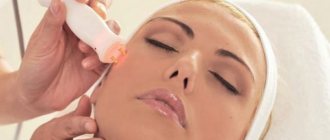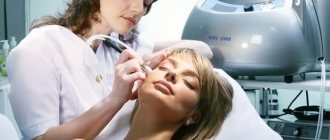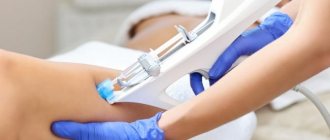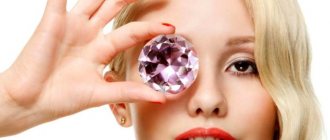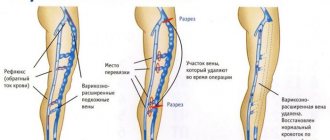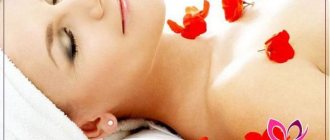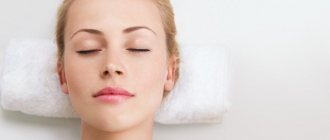From this article you will learn:
- how professional microdermabrasion is performed in a salon,
- Microdermabrasion at home is the best remedy.
Microdermabrasion is a non-surgical procedure that removes the surface layer of skin made up of dead cells. Essentially, this is mechanical peeling of the skin using abrasives. In salons, the procedure is carried out using a special apparatus, from the tip of which a stream of air containing abrasive crystals is released under pressure (Fig. 1-3).
Typically, the abrasives used are aluminum oxide, magnesium oxide, sodium bicarbonate or sodium chloride crystals. The collision of the abrasive with the surface of the skin leads to the sloughing of dead skin cells. Patients often compare their sensations during the procedure to what they feel when a cat licks the face with its rough tongue.
Microdermabrasion 100% copies the Air Flow method in dentistry, which is used to clean teeth from pigmented plaque. This method uses a water-air spray containing soda crystals. As a result, teeth become snow-white.
Important: since human skin recovers in approximately 30-day intervals, you need to understand that skin improvement after professional microdermabrasion in a salon will be temporary. To maintain the results, you must repeat the procedure every 2-4 weeks.
Diamond microdermabrasion of the face: reviews
Removal of the superficial dead layer of skin can be carried out not only with the help of a stream of air with abrasive particles. Recently, devices have appeared whose working nozzles have embedded edges of artificial diamonds on their surface (Fig. 4-5). The doctor simply moves this attachment over the patient’s skin, sanding off the surface layer of skin, and a vacuum suction sucks up the detached skin particles.
The only advantage of this method is that it is safer for use in the patient's eyes and lips, because... there is no air jet with abrasive crystals that can injure the cornea of the eyes or the red border of the lips. But even with the standard technique, such complications usually do not arise. Diamond microdermabrasion is often called diamond facial peeling by patients.
Differences between microdermabrasion and dermabrasion -
Microdermabrasion and dermabrasion are cosmetological methods that are based on mechanical grinding of the skin using abrasive elements. These methods differ only in the depth of skin resurfacing. Microdermabrasion involves removing only the most superficial layer of skin, consisting of dead epidermal cells.
But with dermabrasion, the depth of resurfacing is much greater, which implies subsequent more significant changes in the skin. The dermabrasion method is more radical, requires more qualified doctor and should, as a rule, be performed only by dermatologists or plastic surgeons.
Microdermabrasion: indications
Because This procedure does not cause any noticeable damage to the skin - it is completely safe for most people. Although the face is the most common area for microdermabrasion, this method can be used on absolutely any area of the skin: neck, chest, back, and arms. The skin can become noticeably smoother even after one treatment, and it begins to better absorb moisturizers (creams, oils).
Microdermabrasion is generally recommended for people over 12 years of age and for adults under 65 years of age. Age restrictions are conditional, because People over 65 have a higher risk of bruising and skin abrasions, and people under 12 can receive treatment under the supervision of a dermatologist.
Indications are –
- photoaging of the skin as a result of exposure to sunlight,
- reducing the depth of fine wrinkles,
- age spots,
- in complex therapy of acne (acne),
- if you have superficial acne scars,
- the need to improve complexion (especially for people with yellowish skin).
For acne - dermatologists quite often use microdermabrasion for acne to help clean out deep pores and improve skin condition. Moreover, when treating acne, dermatologists usually use microdermabrasion in combination with superficial chemical peels based on glycolic or acetyl salicylic acids. This combination significantly speeds up recovery (Fig. 9-11).
For melasma - yes, microdermabrasion can be useful in the treatment of melasma and other types of hyperpigmentation (24stoma.ru). Optimal treatment in such situations would include microdermabrasion (every 2-4 weeks) combined with glycolic acid peels (once weekly). The general course of treatment is 6 weeks. In addition, the use of lightening creams (such as hydroquinone 4%) is recommended, as is the daily use of sunscreen.
Microdermabrasion: Before and After photos
How is diamond microdermabrasion performed on the face?
Immediately before microdermabrasion, the specialist assesses the condition of the skin in the areas that will be treated. The skin is cleansed of dirt and cosmetics, and the hair is tucked under a disposable cap.
Microdermabrasion stages:
- Preliminary stage. The face is steamed and moisturizer is applied. The surface of the skin becomes more pliable, which makes it possible to obtain the maximum effect. If the client has a low pain threshold and is afraid of discomfort during the procedure, the skin is treated with an anesthetic.
- Main stage. Then the skin is polished using the device’s attachment. The face is processed sequentially. Diamond microparticles exfoliate all dry dead cells of the epidermis, stimulate the skin, and activate regeneration processes. For areas with more sensitive skin, a specialist can use various attachments.
- The final stage. A nourishing mask is applied to the face after peeling. At this moment, the epidermis actively absorbs the components of the mask, so it gives maximum effect.
Facial microdermabrasion takes about 30 minutes. This is an effective and safe procedure. Despite the fact that the effect is shallow, it triggers skin renewal and helps solve many cosmetic problems.
Microdermabrasion: contraindications
Microdermabrasion - reviews, as a rule, have only positive ones. In addition, this is an extremely safe treatment method. But the possible risks of alternative treatment methods (dermabrasion, laser resurfacing, peeling) are much higher than microdermabrasion.
Contraindications –
- if you are currently taking aspirin or blood thinners.
- Patients using the drug Isotretinoin or who have taken it within the previous 6-12 months – microdermabrasion is contraindicated due to the increased risk of scarring.
Possible TEMPORARY side effects of microdermabrasion:
- skin redness,
- small abrasions (Fig. 12),
- skin sensitivity,
- the appearance of spider veins,
- exacerbation of herpes in the lip area,
- minor bruising (especially if you are taking aspirin or other blood thinners),
- Overly aggressive microdermabrasion can lead to the development of inflammation in certain areas of the skin, and as a result, to areas of inflammatory hyperpigmentation.
How to behave after the procedure -
Most people can return to their normal activities immediately after the procedure. Makeup and non-irritating creams can usually be applied immediately after the procedure. Research has shown that microdermabrasion can temporarily make it easier for substances to penetrate the skin by increasing its permeability. To hydrate and plump the skin after microdermabrasion, it is best to use creams and serums with hyaluronic acid.
Important: remember that after the procedure you must use a moisturizer with sun protection (preferably with SPF 30). This is necessary because UV radiation can cause uneven skin tone.
Microdermabrasion Alternatives –
Due to the fact that the procedure involves only the most superficial layer of the skin, microdermabrasion has the following advantages: firstly, a low risk of complications and side effects, and secondly, rapid skin restoration compared to less gentle methods of skin resurfacing. However, you need to understand that the more gentle the procedure, the less potential benefit it can bring.
Alternatives to microdermabrasion are:
- dermabrasion,
- peeling (chemical),
- skin resurfacing with fractional laser.
In what cases do patients choose microdermabrasion?
The procedure is prescribed for the following indications:
- Resurfacing of scars, regardless of their size.
- Evens out skin tone and eliminates pigmentation, including that left after pregnancy.
- Elimination of traces of shallow burns.
- Fighting wrinkles.
- Skin smoothing.
- Removal of postpartum stretch marks.
When and how is it best to perform mechanical dermabrasion of the face?
Special requirements of specialists relate to air temperature and time of year when the procedure is planned to be carried out:
- from April to the end of October, grinding operations are not recommended;
- You can’t do them if the sun is very active, and you won’t be able to fully hide from it. Otherwise, you can get burns, scars and severe skin hyperpigmentation;
- The ideal time is autumn or winter, when the sun is not very active. It's better to take a vacation to rest up.
Also remember that after deep grinding you cannot visit southern countries for 2 months!
Preparation and carrying out the procedure
Preoperative preparation consists of early (at least 14 days) cessation of smoking, drinking alcohol, hormonal contraceptives and drugs that inhibit blood clotting. Additionally, at the site of the procedure, a test is carried out for allergic reactions and skin healing characteristics.
Due to the painful process, before resurfacing the patient is given anesthesia in the form of general anesthesia or infiltration anesthesia (layer-by-layer local injections of anesthetic). Pre-procedure preparation includes local application of an ice mask to the face in order to make the skin denser and more pliable for resurfacing.
After disinfecting the correction area, the doctor marks it with a marker and begins the operation, which takes place in several stages:
- Removing the epidermal layer using a nylon brush.
- Removal of the basal and papillary layers using a diamond cutter.
- Aligning the treated area with the rest of the skin surface using a metal cutter.
Therapy for keloid scars includes a final step in the form of bucchi irradiation (soft x-rays) to suppress the growth of the keloid neck.
During the session, the capillary loops are injured, so “bloody dew” appears on the patient’s skin. The bleeding continues for about 15 minutes. To stop it, the damaged area is repeatedly (up to 6 times) treated with a solution of potassium permanganate and a hygienic bandage made of non-woven material is applied.
The session takes from 40 to 60 minutes. To achieve a full result, 3 procedures will be required with a difference of 3-6 months.
Video: “Technique and results of dermabrasion”
Is the procedure safe?
The action of exfoliating microcrystals on the skin is gentle. There is no need to be afraid of inflammation and worsening of the condition. If the procedure is performed correctly, contraindications are taken into account, and doctors’ recommendations are followed, everything will go well.
There are three types of microdermabrasion depending on the abrasive. A comparison of these methods is presented in the table. The cosmetologist chooses the type of treatment based on skin type, its condition, and goals.
| Name | Description | Advantages | Flaws |
| Crystalline | Aluminum crystals are used as a grinding agent. They are supplied under pressure by equipment to the skin, then sucked back by a vacuum device with the remnants of the epidermis. | There is no pain for the client during resurfacing, and no recovery period is required. | It is necessary to protect the patient's airway to prevent crystalline microparticles from entering the lungs. Abrasive crystals may remain on the surface of the skin, which can cause an allergic reaction. |
| Diamond | The leather is polished with a special tip, which is treated with diamond dust. The device draws in particles of the epidermis, preventing them from remaining on the skin and mucous membranes. | It does not cause complications and has a stable long-term result. It is recommended to resurface the skin using this method on the neck, décolleté, and arms. There is a noticeable rejuvenation of the skin. | Does not help with deep wrinkles. |
| Combined | A hardware method is used to treat the skin using a mixture of oxygen and aluminum crystals. | Saturates skin cells with oxygen, provides an antibacterial effect on tissues. | Does not remove pigmentation and tattoos. |
Microdermabrasion is safe to use. It does not affect the deep layers of the skin, does not affect the facial muscles, and its substances do not penetrate the circulatory system. The intensity of the impact of the grinding agent is under the supervision of a physician. In many cases, no anesthesia is used, only local anesthesia is used for deeper cleansing.
After performing the cleansing, the client can go home as there is no need for a recovery period. The beauty salon’s specialists select the type of procedure in accordance with the client’s skin type and wishes, so the effect lives up to expectations.
Chemical superficial peeling ↑
It is difficult to find at least one girl who has not heard of chemical peeling. This procedure is very popular in beauty salons, as well as in special clinics. Its essence lies in the fact that a chemical composition is applied to the skin, which, penetrating deep, corrodes the top layer and promotes the generation of new tissue.
This type of peeling has several subtypes, which differ from each other in the depth of their effect on the skin. Of course, at home, even medium peeling is an almost impossible task, and numerous reviews confirm this, since only a specialist can calculate the concentration of the acid, as well as the time required to soak the substance.
You can easily perform a superficial type of procedure on your own. Of course, you won’t be able to get such impressive results as from a medium peel, much less a deep peel, but the effect will be extremely gentle. In addition, if your goal is not to get rid of very deep wrinkles, but just want to renew your facial skin a little, then this peeling will definitely suit you.
Weak acids are found in many fruits and foods. There are even entire lines of cosmetics that use this feature. For example, you can purchase peeling with lactic acid or tartaric acid. If you wish, you can simply use fruits in their original form.
Chemical peeling allows you to successfully combat pore impurities, narrow them and reduce the amount of sebum produced, which is extremely useful for those with overly oily skin.
Salicylic acid copes especially well with this task. It is quite strong, although it is considered superficial, so you should not be surprised if you notice peeling of the skin as a result of the procedure. In any case, no matter what acid you use, you should remember that the peeling mixture is left on the skin for no more than 5 minutes. This time is considered the safest. If the sensations are very unpleasant and you feel a burning sensation, then you should remove the acid from the skin as soon as possible.
Types of facial skin resurfacing
There are now many methods and types of skin resurfacing and, of course, most of them are available only in specialized clinics and salons, because they involve the use of special equipment, tools and drugs.
There are two types of resurfacing available at home: mechanical and chemical peels. Both of them require the use of exfoliators.
The simplest option is to use mechanical peeling. To carry it out, it is not necessary to have special knowledge; it is enough to follow the recipe exactly. As the main component of peeling, any abrasives are suitable, such as nut shells, fine sand, algae
It is only important not to overdo it and not injure the skin. The main rule is that any preparations are applied to moistened skin and removed with warm, not hot water.
Main types and indications for use
Types of dermabrasion differ in the depth of impact:
- surface grinding allows you to remove all layers of the epidermis down to the basement membrane (200 microns);
- middle or moderately deep affects the basal layer of the epidermis (250 µm);
- deep implies intervention at the level of the papillary dermis (300 µm).
Dermabrasion is used for the following disorders of the skin on the face:
- dyschromia;
- scars (hypertrophic, atrophic, keloid);
- deep wrinkles;
- stretch marks (after sudden weight loss/gain, due to hormonal disorders or pregnancy);
- tattoos;
- skin impregnation (deep penetration under the surface of particles of coal, gunpowder, paint, etc.).
These defects are persistent due to their deep location. Mechanical dermabrasion is a hardware resurfacing of the facial skin, which allows you to literally erase a defect from the surface of the skin along with the adjacent tissue. The procedure is carried out using the rotational method - abrasion of the skin layers is carried out through contact with a nozzle made of hard materials, which rotates at high speed.
